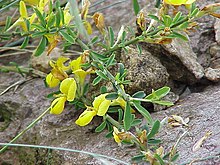Moosheide
|
Moosheide
|
|
|
Heathland |
|
| location | North Rhine-Westphalia , Germany |
| surface | 442.7 ha |
| Identifier |
PB-027 (Hövelhof) GT-017 (Holte-Stukenbrock Castle) |
| Geographical location | 51 ° 52 ' N , 8 ° 40' E |
| Setup date | 1994 |
| administration |
Lower landscape authority of the Gütersloh district, Lower landscape authority of the Paderborn district |
The Moosheide is a cross-district nature reserve with a size of 442.72 hectares , which is mainly (281.83 hectares) in Hövelhof in the Paderborn district and a smaller part (160.89 hectares) in Holte-Stukenbrock Castle in the Gütersloh district. In the area lying seepage of Ems . It is listed with the numbers PB-027 and GT-017. Another 0.59 hectares, listed with the number PB-027E1, are planned as an expansion area.
The area in the Gütersloh district was designated as a nature reserve in 1974, the part in the Paderborn district in 2004. It serves to preserve a geomorphologically distinctive landscape of the upper Senne with geologically significant dune formations, dry sand corridors, heaths, sparse pine forests, geologically significant dry and water-bearing gorge valleys with springs, spring streams and wet meadows.
Location and nature
The Moosheide lies on the western edge of the Senne military training area , on the northern edge is the former main camp VI K (326) , which today houses the " Erich Klausener " police school . In addition to the Ems, the Holtebach is another body of water within the Moosheide.
The sand dunes in the area are counted among the oldest in northwest Germany ; it is believed that they developed from the end of the Vistula Ice Age , i.e. around 10,000 years ago. Due to afforestation that took place in the middle of the 19th century, they provide space for sparse pine forests . Old juniper plants in the nature reserve testify to the original heather vegetation that was typical of the region before the reforestation.
flora
Notable plant species that occur here include pines, including club moss , hairy gorse , nodding wintergreen , hollow-toothed seed and juniper .
fauna
99 bird species were detected, 39 of which were on the Red List or on the warning list of endangered species of the state of North Rhine-Westphalia. These include the kingfisher , woodlark , blackcap , sand martin , and also the natterjack toad and sand lizard .
Others
The area has been accessible via a natural history trail since 1994 . An accompanying brochure contains explanations of 21 stations. Senner horses are used on some areas to graze and keep the landscape open.
Individual evidence
- ^ "Moosheide" nature reserve in the specialist information system of the State Office for Nature, Environment and Consumer Protection in North Rhine-Westphalia , accessed on February 28, 2017.
- ↑ a b Nature Conservation Center Senne ( Memento from February 10, 2013 in the web archive archive.today )
Web links
- Nature reserve "Moosheide (Paderborn district)" in the specialist information system of the State Office for Nature, Environment and Consumer Protection in North Rhine-Westphalia
- Nature reserve "Moosheide (Gütersloh district)" in the specialist information system of the State Office for Nature, Environment and Consumer Protection in North Rhine-Westphalia
- Senne biological station: Moosheide nature reserve
- World Database on Protected Areas - Moosheide, Paderborn District (English)
- World Database on Protected Areas - Moosheide, Gütersloh District (English)




